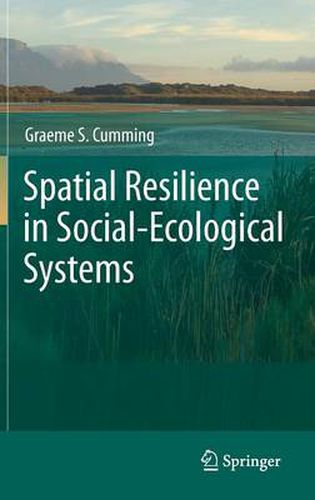Readings Newsletter
Become a Readings Member to make your shopping experience even easier.
Sign in or sign up for free!
You’re not far away from qualifying for FREE standard shipping within Australia
You’ve qualified for FREE standard shipping within Australia
The cart is loading…






This title is printed to order. This book may have been self-published. If so, we cannot guarantee the quality of the content. In the main most books will have gone through the editing process however some may not. We therefore suggest that you be aware of this before ordering this book. If in doubt check either the author or publisher’s details as we are unable to accept any returns unless they are faulty. Please contact us if you have any questions.
Spatial Resilience is a new and exciting area of interdisciplinary research. It focuses on the influence of spatial variation - including such things as spatial location, context, connectivity, and dispersal - on the resilience of complex systems, and on the roles that resilience and self-organization play in generating spatial variation. Prof. Cumming provides a readable introduction and a first comprehensive synthesis covering the core concepts and applications of spatial resilience to the study of social-ecological systems. The book follows a trajectory from concepts through models, methods, and case study analysis before revisiting the central problems in the further conceptual development of the field. In the process, the author ranges from the movements of lions in northern Zimbabwe to the urban jungles of Europe, and from the collapse of past societies to the social impacts of modern conflict. The many case studies and examples discussed in the book show how the concept of spatial resilience can generate valuable insights into the spatial dynamics of social-ecological systems and contribute to solving some of the most pressing problems of our time. Although it has been written primarily for students, this book will provide fascinating reading for interdisciplinary scientists at all career stages as well as for the interested public.
Graeme Cumming, central in the development of resilience thinking and theory, has produced a wonderful book on spatial resilience, the first ever on this topic. The book will become a shining star, a classic in the explosion of new ideas and approaches to studying and understanding social-ecological systems.
Carl Folke, Stockholm Resilience Centre, Sweden
$9.00 standard shipping within Australia
FREE standard shipping within Australia for orders over $100.00
Express & International shipping calculated at checkout
This title is printed to order. This book may have been self-published. If so, we cannot guarantee the quality of the content. In the main most books will have gone through the editing process however some may not. We therefore suggest that you be aware of this before ordering this book. If in doubt check either the author or publisher’s details as we are unable to accept any returns unless they are faulty. Please contact us if you have any questions.
Spatial Resilience is a new and exciting area of interdisciplinary research. It focuses on the influence of spatial variation - including such things as spatial location, context, connectivity, and dispersal - on the resilience of complex systems, and on the roles that resilience and self-organization play in generating spatial variation. Prof. Cumming provides a readable introduction and a first comprehensive synthesis covering the core concepts and applications of spatial resilience to the study of social-ecological systems. The book follows a trajectory from concepts through models, methods, and case study analysis before revisiting the central problems in the further conceptual development of the field. In the process, the author ranges from the movements of lions in northern Zimbabwe to the urban jungles of Europe, and from the collapse of past societies to the social impacts of modern conflict. The many case studies and examples discussed in the book show how the concept of spatial resilience can generate valuable insights into the spatial dynamics of social-ecological systems and contribute to solving some of the most pressing problems of our time. Although it has been written primarily for students, this book will provide fascinating reading for interdisciplinary scientists at all career stages as well as for the interested public.
Graeme Cumming, central in the development of resilience thinking and theory, has produced a wonderful book on spatial resilience, the first ever on this topic. The book will become a shining star, a classic in the explosion of new ideas and approaches to studying and understanding social-ecological systems.
Carl Folke, Stockholm Resilience Centre, Sweden